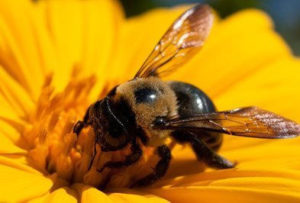
Do you think that all bees make honey? Unfortunately, that is not the case. Other types of bees include bumblebees and carpenter bees. The next time you spot a bee’s nest, have the facts to determine what type of bee it is and what potential damage it can do to your home.
What Do Bees Look Like?
A carpenter bee can look like many other bees. It has the same structure as other types of bees, with a fuzzy thorax that might be yellow, white, black, or brown in color; four black legs; antennae; and a black, shiny abdomen. Carpenter bees differ from bumblebees in that their abdomen is hairless.
In contrast, a bumblebee can be orange or red in color and have a pollen basket so that they can easily collect pollen. Their abdomens are either rounded or pointed, based on their gender. Honeybees are often bigger and heavier than bumblebees.
Honey Bees are oval shaped with no waist, like wasps, and look much hairier than a yellow jacket and are not as aggressive. Their coloring is striated with brown and yellow so they also look lighter than a yellow jacket. They are slow flyers and are usually found around flowers to gather pollen for honey.
What Are Bees’ Nesting Habits?
Honeybees often nest inside trees. Their nests are typically made of wax and honeycombs. Within their nests, honeybees store their food, pollen, and honey and raise the generation of honeybees. Honeybee nests consist of workers, queens, and drones.
However, honeybees also can nest in structures that beekeepers make. These structures, usually of wood, clay, and mud, are meant to help bees make honey by mimicking and protecting the nests inside the structure.
Bumblebees will nest inside of whatever space they can find. For example, you might find them in a hole, crack, or gap in or around your home. These nest sites often are close to the ground, such as under piles of wood or leaves or even abandoned bird’s nests.
Bumblebees often nest and mate in the spring, with workers that collect pollen and live for only a month and queens that provide all the bees and last throughout the winter. As many bees die off quickly, each spring, the queens begin a new nest.
Carpenter bees nest in wood. They will nest in any wood they can find, including trees, porches, or wooden homes. They mate in the spring, settle down to hatch the next generation of bees, and raise them. Carpenter bees’ nests can last through the winter.
What Damage Can They Do?
All bees can be dangerous to some extent. For example, many bees sting, which can be simply painful for many and potentially fatal for some.
Honeybees can only sting once before they die. However, many people are allergic, and one sting can be enough for a bad reaction.
Bumblebees have stingers as well and can sting multiple times. This can prove disastrous to those who are allergic. However, these bees won’t sting a person unless that person disturbs their nest or the bee itself. Also, only females can sting.
Carpenter bees are more dangerous in that they can damage wood. Though they don’t eat it, they burrow into the wood for nesting and hatching. If undetected, a carpenter bee’s nest can expand and eventually cause damage to a home. Additionally, female carpenter bees can sting people.
What Should You Do If You See Bees?
If you see any type of bee around your home, speak to a pest control expert as soon as possible, especially if you’re unsure what type of bee you saw. A pest control expert can help determine the bee species you saw, the potential damage they could do, and the danger they may pose to your family and property. The pest control professional can also provide treatment if necessary to get rid of the bee problem.
Additionally, a pest control expert can point out if a bee sighting is actually a good thing. Many people raise bees for honey, and some bees pose little threat if people know what to do. Plus, bumblebees can help the environment with their contributions as pollinators.
Please reach out to Guardian Pest Control for all your bee-related questions. We will be happy to identify and treat bees in and around your property.
